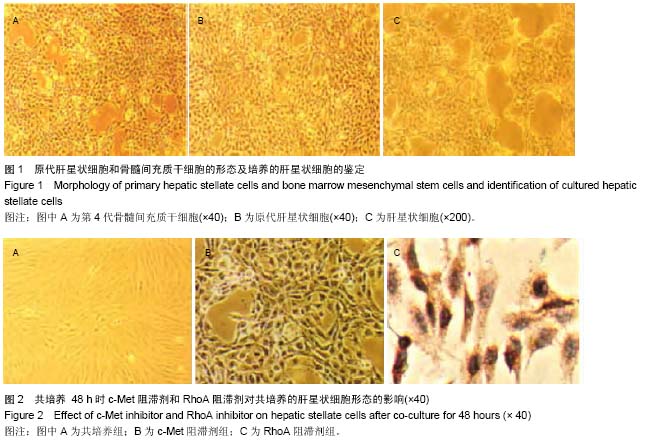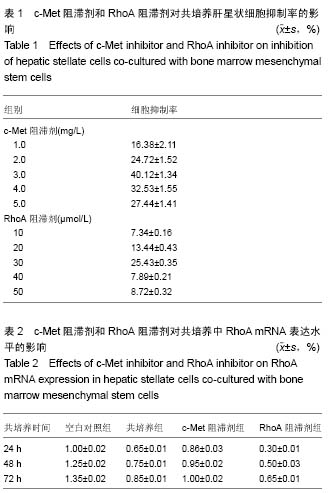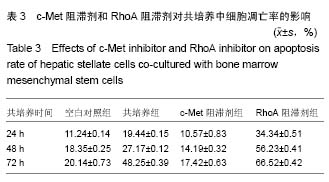| [1] 姚志成,钟跃思,胡昆鹏,等.骨髓间质干细胞培养液上清对肝星状细胞增殖及纤维化的影响[J].中国组织工程研究与临床康复, 2011,15(23):4181-4184.
[2] 林有智,陆玉蕾,陈孝平,等.肝细胞生长因子在肝星状细胞调控卵圆细胞凋亡中的作用[J].腹部外科,2013,26(2):133-135.
[3] 孟云超,姜海行,张君红,等.肝细胞生长因子的激活诱导肝星状细胞凋亡[J].中华肝脏病杂志,2012,20(9):698-702.
[4] 孔德松,郑仕中,陆茵,等.肝内肌成纤维细胞的来源及其在肝纤维化中作用的研究[J].中国药理学通报,2011,27(3):297-300.
[5] 苏思标,姜海行,王东旭,等.骨髓间充质干细胞调控肝星状细胞RhoA、P27的表达[J].世界华人消化杂志,2009,17(32):3283-3291.
[6] 陈国忠,姜海行,陆正峰,等.骨髓间充质干细胞共培养对肝星状细胞增殖、凋亡和RohA表达的调控[J].世界华人消化杂志,2010, 18(16):1643-1649.
[7] 王珊,张立婷,陈红.人骨髓间充质干细胞培养上清与肝星状细胞相关酶的分泌[J].中国组织工程研究,2012,16(45):8374-8379.
[8] 王东旭,姜海行,苏思标,等.体外共培养大鼠骨髓间充质干细胞对肝星状细胞增殖的影响:Cyclin D1与P27表达调控[J].中国组织工程研究与临床康复,2010,14(10):1764-1768.
[9] 宁琳,姜海行,覃山羽,等.骨髓充质干细胞调控尿激酶型纤溶酶原激活物表达及其对大鼠肝星状细胞凋亡的影响[J].中国组织工程研究,2012,16(19):3427-3432.
[10] 胡昆鹏,刘波,姚志成,等.骨髓间充质干细胞与肝星状细胞共培养后凋亡相关基因的改变[J].中国组织工程研究,2014,18(28): 4444-4449.
[11] 张君红,姜海行,覃山羽,等.肝细胞生长因子在TRAIL促进原代肝星状细胞凋亡中的作用[J].中国老年学杂志,2013,33(23):5909-5911.
[12] Chan KM, Fu YH, Wu TJ, et al. Hepatic stellate cells promote the differentiation of embryonic stem cell-derived definitive endodermal cells into hepatic progenitor cells. Hepatol Res. 2013;43(6):648-657.
[13] 潘若浪.间充质干细胞抗肝脏纤维化作用及其机制的探索研究[D].杭州:浙江大学,2011.
[14] Chen S, Xu L, Lin N, et al. Activation of Notch1 signaling by marrow-derived mesenchymal stem cells through cell-cell contact inhibits proliferation of hepatic stellate cells. Life Sci. 2011;89(25-26):975-981.
[15] Deng X, Chen YX, Zhang X, et al. Hepatic stellate cells modulate the differentiation of bone marrow mesenchymal stem cells into hepatocyte-like cells. J Cell Physiol. 2008; 217(1): 138-144.
[16] 杨文,覃山羽,姜山羽,等.骨髓间充质干细胞体外调控肝星状细胞死亡受体5的表达[J].中国组织工程研究,2012,16(27):4947- 4952.
[17] Nishiofuku M, Yoshikawa M, Ouji Y, et al. Modulated differentiation of embryonic stem cells into hepatocyte-like cells by coculture with hepatic stellate cells. J Biosci Bioeng. 2011;111(1):71-77.
[18] Tennakoon AH, Izawa T, Wijesundera KK, et al. Characterization of glial fibrillary acidic protein (GFAP)-expressing hepatic stellate cells and myofibroblasts in thioacetamide (TAA)-induced rat liver injury. Exp Toxicol Pathol. 2013;65(7-8):1159-1171.
[19] Suskind DL, Muench MO. Searching for common stem cells of the hepatic and hematopoietic systems in the human fetal liver: CD34+ cytokeratin 7/8+ cells express markers for stellate cells. J Hepatol. 2004;40(2):261-268.
[20] 罗茜,王斌,雷增杰,等.肝星状细胞具有向肝细胞样细胞分化的干细胞潜能[J].第三军医大学学报,2013,35(7):604-608.
[21] 常文举,宋陆军,徐兴远,等.小鼠肝星状细胞对肝脏干细胞增殖及代谢的影响[J].中华实验外科杂志,2014,31(5):988-990.
[22] 邓星.活化肝星状细胞促进干细胞定向分化和肝损伤修复[D].上海:第二军医大学,2008.
[23] 李明亮,姚志成,钟跃思,等.人脐带间质干细胞培养上清液可下调肝星状细胞转化生长因子β的表达[J].中国组织工程研究,2012, 16(10):1769-1772.
[24] 俞富祥,苏龙丰,季世强,等.脂肪间质干细胞抑制肝星状细胞增殖活化及肝脏纤维化[J].中华普通外科杂志,2011,26(12): 1027- 1030.
[25] Lin N, Tang Z, Deng M, et al. Hedgehog-mediated paracrine interaction between hepatic stellate cells and marrow-derived mesenchymal stem cells. Biochem Biophys Res Commun. 2008;372(1):260-265.
[26] Zhang SC, Zheng YH, Yu PP, et al. Lentiviral vector-mediated down-regulation of IL-17A receptor in hepatic stellate cells results in decreased secretion of IL-6. World J Gastroenterol. 2012;18(28):3696-3704.
[27] 李里明.人脐带间质干细胞来源的exosomes对肝星状细胞活化的抑制研究[D].镇江:江苏大学,2014.
[28] 赵建学,商洪涛,郭海燕,等.骨髓间充质干细胞对四氯化碳诱发大鼠肝纤维化的治疗作用的实验研究[J].实用临床医药杂志,2011, 15(7):13-15,20.
[29] 陈黎明,徐若男,吕飒,等.脐带间充质干细胞对肝星状细胞活化、凋亡的调控作用研究[J].解放军医学杂志,2014,39(1):11-14.
[30] 姚志成,胡昆鹏,陈思,等.骨髓间质干细胞通过影响PI3K/Akt信号通路抑制肝星状细胞的增殖[J].中华实验外科杂志,2011,28(9): 1475-1477.
[31] 张君红,姜海行,孟云超,等.大鼠骨髓间充质干细胞旁分泌HGF上调肝星状细胞DR5及caspase-8的表达[J].基础医学与临床, 2012, 32(7):804-808.
[32] 何颖.间充质干细胞与肝星状细胞相互作用及其与抗肝纤维化[J].南昌大学学报(医学版),2011,51(4):89-92.
[33] 俞富祥,季世强,苏龙丰,等.脂肪间质干细胞对肝星状细胞活化、增殖、凋亡相关作用的研究[J].医学研究杂志,2012,41(3):79-82. |


